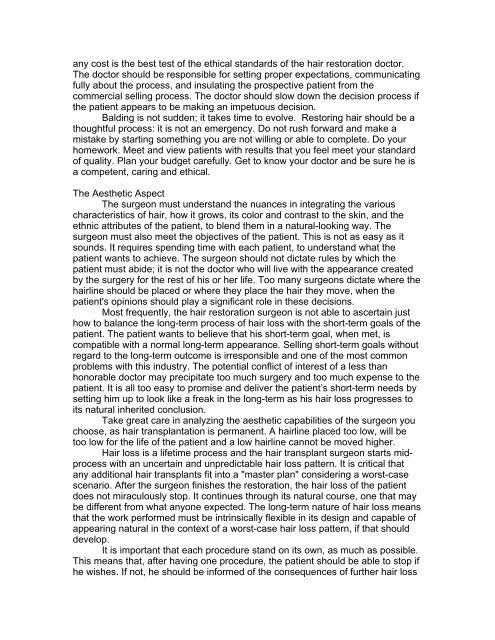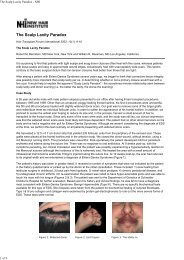The Patient's Guide to Hair Restoration - New Hair Institute
The Patient's Guide to Hair Restoration - New Hair Institute
The Patient's Guide to Hair Restoration - New Hair Institute
Create successful ePaper yourself
Turn your PDF publications into a flip-book with our unique Google optimized e-Paper software.
any cost is the best test of the ethical standards of the hair res<strong>to</strong>ration doc<strong>to</strong>r.<br />
<strong>The</strong> doc<strong>to</strong>r should be responsible for setting proper expectations, communicating<br />
fully about the process, and insulating the prospective patient from the<br />
commercial selling process. <strong>The</strong> doc<strong>to</strong>r should slow down the decision process if<br />
the patient appears <strong>to</strong> be making an impetuous decision.<br />
Balding is not sudden; it takes time <strong>to</strong> evolve. Res<strong>to</strong>ring hair should be a<br />
thoughtful process: it is not an emergency. Do not rush forward and make a<br />
mistake by starting something you are not willing or able <strong>to</strong> complete. Do your<br />
homework. Meet and view patients with results that you feel meet your standard<br />
of quality. Plan your budget carefully. Get <strong>to</strong> know your doc<strong>to</strong>r and be sure he is<br />
a competent, caring and ethical.<br />
<strong>The</strong> Aesthetic Aspect<br />
<strong>The</strong> surgeon must understand the nuances in integrating the various<br />
characteristics of hair, how it grows, its color and contrast <strong>to</strong> the skin, and the<br />
ethnic attributes of the patient, <strong>to</strong> blend them in a natural-looking way. <strong>The</strong><br />
surgeon must also meet the objectives of the patient. This is not as easy as it<br />
sounds. It requires spending time with each patient, <strong>to</strong> understand what the<br />
patient wants <strong>to</strong> achieve. <strong>The</strong> surgeon should not dictate rules by which the<br />
patient must abide; it is not the doc<strong>to</strong>r who will live with the appearance created<br />
by the surgery for the rest of his or her life. Too many surgeons dictate where the<br />
hairline should be placed or where they place the hair they move, when the<br />
patient's opinions should play a significant role in these decisions.<br />
Most frequently, the hair res<strong>to</strong>ration surgeon is not able <strong>to</strong> ascertain just<br />
how <strong>to</strong> balance the long-term process of hair loss with the short-term goals of the<br />
patient. <strong>The</strong> patient wants <strong>to</strong> believe that his short-term goal, when met, is<br />
compatible with a normal long-term appearance. Selling short-term goals without<br />
regard <strong>to</strong> the long-term outcome is irresponsible and one of the most common<br />
problems with this industry. <strong>The</strong> potential conflict of interest of a less than<br />
honorable doc<strong>to</strong>r may precipitate <strong>to</strong>o much surgery and <strong>to</strong>o much expense <strong>to</strong> the<br />
patient. It is all <strong>to</strong>o easy <strong>to</strong> promise and deliver the patient’s short-term needs by<br />
setting him up <strong>to</strong> look like a freak in the long-term as his hair loss progresses <strong>to</strong><br />
its natural inherited conclusion.<br />
Take great care in analyzing the aesthetic capabilities of the surgeon you<br />
choose, as hair transplantation is permanent. A hairline placed <strong>to</strong>o low, will be<br />
<strong>to</strong>o low for the life of the patient and a low hairline cannot be moved higher.<br />
<strong>Hair</strong> loss is a lifetime process and the hair transplant surgeon starts midprocess<br />
with an uncertain and unpredictable hair loss pattern. It is critical that<br />
any additional hair transplants fit in<strong>to</strong> a "master plan" considering a worst-case<br />
scenario. After the surgeon finishes the res<strong>to</strong>ration, the hair loss of the patient<br />
does not miraculously s<strong>to</strong>p. It continues through its natural course, one that may<br />
be different from what anyone expected. <strong>The</strong> long-term nature of hair loss means<br />
that the work performed must be intrinsically flexible in its design and capable of<br />
appearing natural in the context of a worst-case hair loss pattern, if that should<br />
develop.<br />
It is important that each procedure stand on its own, as much as possible.<br />
This means that, after having one procedure, the patient should be able <strong>to</strong> s<strong>to</strong>p if<br />
he wishes. If not, he should be informed of the consequences of further hair loss



